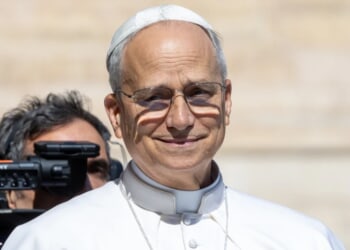
After decades of steady decline, the share of Americans identifying as Christian has stabilized. One reason is the unexpected religiosity of Generation Z—young adults born after 2000—who are not abandoning religion at the rate their parents did. For some, faith has become a form of rebellion against a culture that rejects traditional values.
According to the Pew Research Center’s latest Religious Landscape Study, 63 percent of Americans now identify as Christian—a slight increase from the 2022 low of 60 percent and part of a five-year trend of relative stability following nearly two decades of decline. The study analyzed respondents by birth decade and found that every twentieth-century cohort showed a drop in Christian identification compared with the previous one. For example, 80 percent of the group born in the 1940s and earlier identify as Christian, compared with just 46 percent of those born in the 1990s. But among those born in the 2000s, the rate held steady at the 1990s level, suggesting that the generational decline may have plateaued.
Finally, a reason to check your email.
Sign up for our free newsletter today.
More broadly, the Pew study found that Christianity is increasingly a marker of conservative political identity across all age groups. Since 2007, the share of conservatives identifying as Christian has declined only modestly—by 7 percentage points. Among liberals, however, Christian identification has dropped sharply, falling 25 points—from 62 percent to 37 percent. Today, conservatives are 45 percentage points more likely to identify as Christian than liberals are.
These results reflect, in part, the devastating cultural losses that Christians have suffered since the 1960s. At the judicial level, Christians were defeated in a series of Supreme Court decisions, which began by banning school prayer and concluded by effectively recognizing “gender identity” as a protected class under federal civil rights law. At the social level, Christians witnessed the widespread acceptance of divorce, abortion, and same-sex marriage, as well as growing social penalties for those who dissent. These cultural shifts coincided with a steep decline in Christian affiliation—down from 91 percent of Americans in 1976—and in religious practice, with fewer than half of self-identified Christians now attending in-person church services even once a month.
Yet these cultural losses may have laid the groundwork for a revival. Public Christianity in the United States receded in part because a rising counterculture successfully challenged its restrictions on individual conduct. Advocates of cultural liberalization gained support by portraying mid-century Christian institutions as rigid and outdated. But today, that once-rebellious counterculture dominates the spaces that Americans inhabit—schools, workplaces, and popular media. And young people, always drawn to rebellion, appear to be pushing back. Many are rejecting a culture that exalts personal autonomy and denigrates self-sacrifice. Perhaps as a result, a surprising number of young adults—who might otherwise have left religion at even higher rates than their parents did—are, for the first time in decades, choosing to stay.
This quiet rebellion is driving renewed interest in traditional forms of worship. The youngest cohort of Catholic priests is notably more conservative than previous generations. The New York Post reports that young men, “longing for a more traditional faith,” are converting to Orthodox Christianity “in droves.” Attend an Orthodox or traditional Catholic liturgy in any major American city, and you’ll likely see young men in suits and even women in veils, worshipping much as their great-grandparents did.
One reason for this turn may be that, despite its victories, the counterculture still draws heavily on Christianity. Progressives may be wary of institutional religion, but their ideals—uplifting the poor, welcoming the stranger, protecting the marginalized—are rooted in Christian moral tradition. These causes retain moral weight precisely because Christianity remains culturally resonant, even if unacknowledged.
It’s too soon to say whether Christianity’s long decline in America has bottomed out, or if a genuine revival is taking shape. Either way, much will hinge on the choices of the young. “Teenagers have a potency for sacrifice which is far greater than adults realize,” said Archbishop Fulton J. Sheen in the 1950s. “They want to make a surrender, a commitment, an engagement . . . something that’s worth dying for.” Christianity still offers that—something the counterculture never truly could.
Photo: Maskot / DigitalVision via Getty Images
City Journal is a publication of the Manhattan Institute for Policy Research (MI), a leading free-market think tank. Are you interested in supporting the magazine? As a 501(c)(3) nonprofit, donations in support of MI and City Journal are fully tax-deductible as provided by law (EIN #13-2912529).
Source link

















